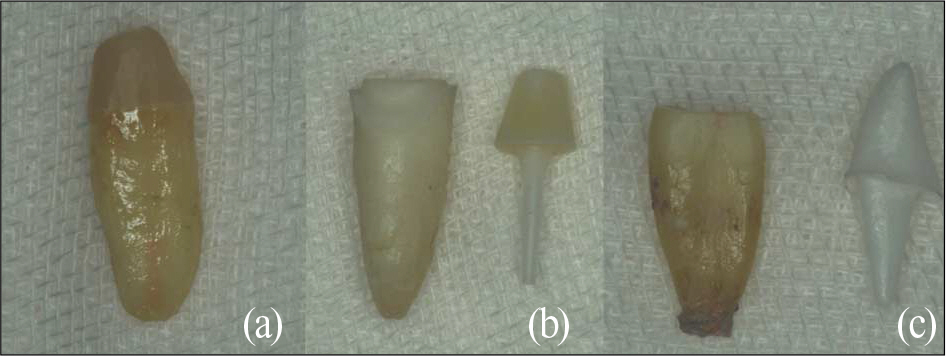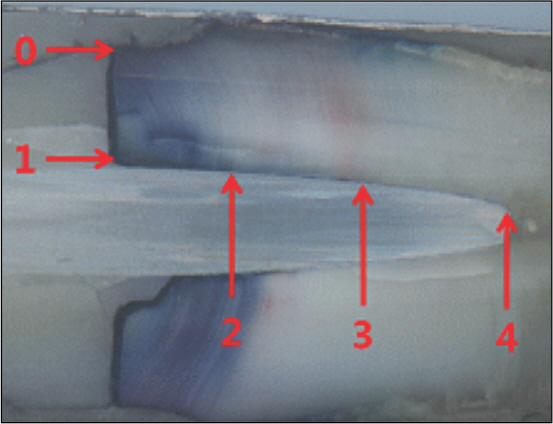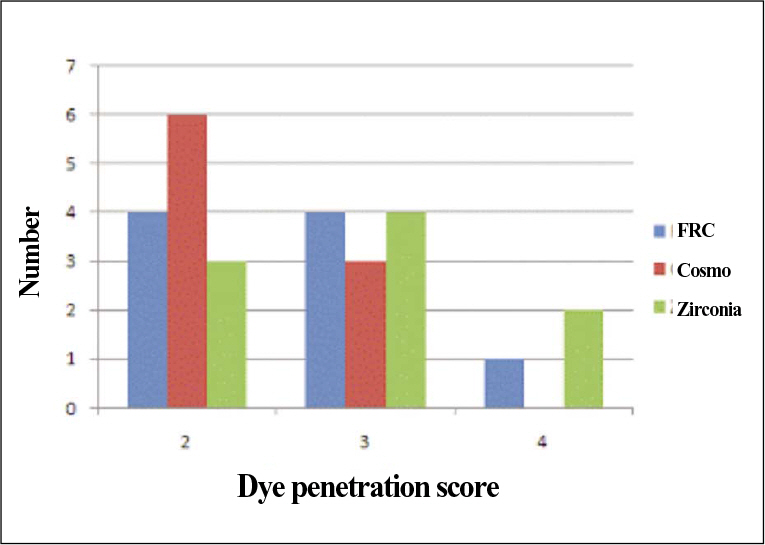J Korean Acad Prosthodont.
2009 Jan;47(1):53-60. 10.4047/jkap.2009.47.1.53.
Microleakage of endodontically treated teeth restored with three different esthetic post and cores
- Affiliations
-
- 1Department of Dental Prosthodontics, School of Medicine, Ewha Womans University, Korea. prosth@ewha.ac.kr
- 2Department of Prosthodontics, School of Dentistry, Seoul National University, Korea.
- KMID: 2000386
- DOI: http://doi.org/10.4047/jkap.2009.47.1.53
Abstract
- STATEMENT OF PROBLEM: At present, as the esthetic demands are on the increase, there are many ongoing studies for tooth-colored post and cores. Most of them are about fiber post and prefabricated zirconia post, but few about one-piece milled zirconia post and core using CAD/CAM (computer-aided design / computer-aided manufacturing) technique.
PURPOSE: The objective of this study was to compare microleakage of endodontically treated teeth restored with three different tooth-colored post and cores.
MATERIAL AND METHODS: Extracted 27 human maxillary incisors were cut at the cementoenamel junction, and the teeth were endodontically treated. Teeth were divided into 3 groups (n = 9); restored with fiber post and resin core, prefabricated zirconia post and heat - pressed ceramic core, and CAD/CAM milled zirconia post and core. After the preparation of post space, each post was cemented with dual-polymerized resin cement (Variolink II). Teeth were thermocycled for 1000 cycles between 5 - 55 degrees C and dyed in 2 percent methylene blue at 37 degrees C for 24 hours. Teeth were sectioned (bucco - lingual), kept the record of microleakage and then image-analyzed using a microscope and computer program. The data were analyzed by one-way ANOVA and Scheffe's multiple range test (alpha= 0.05).
RESULTS
All groups showed microleakage and there were no significant differences among the groups (P > .05). Prefabricated zirconia post and heat-pressed ceramic core showed more leakage in dye penetration at the post - tooth margin, but there was little microleakage at the end of the post. Fiber post and resin core group and CAD/CAM milled zirconia post and core group indicated similar microleakage score in each stage.
CONCLUSION
Prefabricated zirconia post and heat-pressed ceramic core group demonstrated better resistance to leakage, and fiber post and resin core group and CAD/CAM milled zirconia post and core group showed the similar patterns. The ANOVA test didn't indicate significant differences in microleakage among test groups. (P > .05)
Keyword
MeSH Terms
Figure
Reference
-
1.Heydecke G., Butz F., Hussein A., Strub JR. Fracture strength after dynamic loading of endodontically treated teeth restored with different post-and-core systems. J Prosthet Dent. 2002. 87:438–45.
Article2.Hudis SI., Goldstein GR. Restoration of endodontically treated teeth: a review of the literature. J Prosthet Dent. 1986. 55:33–8.
Article3.Morgano SM., Milot P. Clinical success of cast metal posts and cores. J Prosthet Dent. 1993. 70:11–6.
Article4.Shillingburg HT., Kessler JC. Restoration of the endodontically treated tooth. Chicago: Quintessence;1982. p. 131–45.5.Kwon TH., Hwang JW., Kim SH., Shin SW. Finite element analysis of the influence of esthetic posts on incisors. J Korean Acad Prosthodont. 2003. 41:582–95.6.King PA., Setchell DJ. An in vitro evaluation of a prototype CFRC prefabricated post developed for the restoration of pulpless teeth. J Oral Rehabil. 1990. 17:599–609.
Article7.Purton DG., Payne JA. Comparison of carbon fiber and stainless steel root canal posts. Quintessence Int. 1996. 27:93–7.8.Torbjorner A., Karlsson S., Syverud M., Hensten-Pettersen A. Carbon fiber reinforced root canal posts. Mechanical and cytotoxic properties. Eur J Oral Sci. 1996. 104:605–11.
Article9.Cales B., Stefani Y., Lilley E. Long-term in vivo and in vitro aging of a zirconia ceramic used in orthopaedy. J Biomed Mater Res. 1994. 28:619–24.10.Zhang YX., Zhang WH., Lu ZY., Wang KL. Fracture strength of custom-fabricated Celay all-ceramic post and core restored endodontically treated teeth. Chin Med J. 2006. 119:1815–20.
Article11.Dilmener FT., Sipahi C., Dalkiz M. Resistance of three new esthetic post-and-core systems to compressive loading. J Prosthet Dent. 2006. 95:130–6.
Article12.Friedel W., Kern M. Fracture strength of teeth restored with all-ceramic posts and cores. Quintessence Int. 2006. 37:289–95.13.Jung SH., Min KS., Chang HS., Park SD., Kwon SN., Bae JM. Microleakage and fracture patterns of teeth restored with different posts under dynamic loading. J Prosthet Dent. 2007. 98:270–6.
Article14.Streacker AB., Geissberger M. The milled ceramic post and core: A functional and esthetic alternative. J Prosthet Dent. 2007. 98:486–7.
Article15.Reid LC., Kazemi RB., Meiers JC. Effect of fatigue testing on core integrity and post microleakage of teeth restored with different post systems. J Endod. 2003. 29:125–31.
Article16.Raygot CG., Chai J., Jameson DL. Fracture resistance and primary failure mode of endodontically treated teeth restored with a carbon fiber-reinforced resin post system in vitro. Int J Prosthodont. 2001. 14:141–5.17.Akkayan B. An in vitro study evaluating the effect of ferrule length on fracture resistance of endodontically treated teeth restored with fiber-reinforced and zirconia dowel systems. J Prosthet Dent. 2004. 92:155–62.
Article18.Demirel F., Saygili G., Sahmali S. Microleakage of endodontically treated teeth restored with prefabricated posts and tooth-colored restorative materials. Int J Periodontics Restorative Dent. 2005. 25:73–9.19.Toksavul S., Tu ¨ rku ¨ n M., Toman M. Esthetic enhancement of ceramic crowns with zirconia dowels and cores: a clinical report. J Prosthet Dent. 2004. 92:116–9.
Article20.Salameh Z., Sorrentino R., Ounsi HF., Goracci C., Tashkandi E., Tay FR., Ferrari M. Effect of different all-ceramic crown system on fracture resistance and failure pattern of endodontically treated maxillary premolars restored with and without glass fiber posts. J Endod. 2007. 33:848–51.
Article21.D' Arcangelo C., De Angelis F., Vadini M., Zazzeroni S., Ciampoli C., D' Amario M. In vitro fracture resistance and deflection of pulpless teeth restored with fiber posts and prepared for veneers. J Endod. 2008. 34:838–41.22.Johnson JK., Sakumura JS. Dowel form and tensile force. J Prosthet Dent. 1978. 40:645–9.
Article23.Zahran M., El-Mowafy O., Tam L., Watson PA., Finer Y. Fracture strength and fatigue resistance of all-ceramic molar crowns manufactured with CAD/CAM technology. J Prosthodont. 2008. 17:370–7.
Article24.Persson AS., Andersson M., Ode ´ n A., Sandborgh-Englund G. Computer aided analysis of digitized dental stone replicas by dental CAD/CAM technology. Dent Mater. 2008. 24:1123–30.
Article25.Bergman B., Lundquist P., Sjogren U., Sundquist G. Restorative and endodontic results after treatment with cast posts and cores. J Prosthet Dent. 1989. 61:10–5.
Article26.Creugers NH., Mentink AG., Ka ¨ yser AF. An analysis of durability data on post and core restorations. J Dent. 1993. 21:281–4.
Article27.Isidor F., Odman P., Br�ndum K. Intermittent loading of teeth restored using prefabricated carbon fiber posts. Int J Prosthodont. 1996. 9:131–6.28.Fredriksson M., Astba ¨ ck J., Pamenius M., Arvidson K. A retrospective study of 236 patients with teeth restored by carbon fiber-reinforced epoxy resin posts. J Prosthet Dent. 1998. 80:151–7.
Article29.Chan RW., Bryant RW. Post-core foundations for endodontically treated posterior teeth. J Prosthet Dent. 1982. 48:401–6.
Article30.Oliva RA., Lowe JA. Dimensional stability of composite used as a core material. J Prosthet Dent. 1986. 56:554–61.
Article31.LLarson TD., Jensen JR. Microleakage of composite resin and amalgam core material under complete cast crowns. J Prosthet Dent. 1980. 44:40–4.32.Kovarik RE., Breeding LC., Caughman WF. Fatigue life of three core materials under simulated chewing conditions. J Prosthet Dent. 1992. 68:584–90.
Article33.Yun MJ., Lee SH., Yang JH. Effect of type and cementation method of post-core on microleakage. J Korean Acad Prosthodont. 1994. 32:225–33.34.Mixson JM., Eick JD., Moore DL., Tira DE. Effect of two dentin bonding agents on microleakage in two different cavity designs. J Prosthet Dent. 1992. 67:441–5.
Article35.Crim GA. Influence of bonding agents and composites on microleakage. J Prosthet Dent. 1989. 61:571–4.
Article36.Crim GA., Garcia-Godoy F. Microleakage: the effect of storage and cycling duration. J Prosthet Dent. 1987. 57:574–6.
Article37.Sparrius O., Grossman ES. Marginal leakage of composite resin restorations in combination with dentinal and enamel bonding agents. J Prosthet Dent. 1989. 61:678–84.
Article38.Paek SH., Chang IT., Lee SH., Yang JH., Heo SJ. A study of core type and luting cements on complete cast crown retention. J Korean Acad Prosthodont. 2000. 38:169–77.39.Gregory WA., Griffiths L., Irwin G. Effects of intra-core mechanical interlocks and cement type on full crown retention. Am J Dent. 1991. 4:29–32.40.Hoag EP., Dwyer TG. A comparative evaluation of three post and core techniques. J Prosthet Dent. 1982. 47:177–81.
Article41.Butz F., Lennon AM., Heydecke G., Strub JR. Survival rate and fracture strength of endodontically treated maxillary incisors with moderate defects restored with different post-and-core systems: an in vitro study. Int J Prosthodont. 2001. 14:58–64.42.Heydecke G., Butz F., Strub JR. Fracture strength and survival rate of endodontically treated maxillary incisors with approximal cavities after restoration with different post and core systems: an in-vitro study. J Dent. 2001. 29:427–33.
Article
- Full Text Links
- Actions
-
Cited
- CITED
-
- Close
- Share
- Similar articles
-
- In vitro study of microleakage of endodontically treated teeth restored with different adhesive systems and fiber-reinforced posts
- A STUDY OF THE MICROLEAKAGE AT THE POST AND CORE AND TOOTH INTERFACE
- Comparison of fracture strength and pattern of endodontically treated teeth restored with fiber posts and metal cast post
- Fracture strength and fracture mode of resin root analogs restored with various post and core materials
- Fracture resistance of upper central incisors restored with different posts and cores





